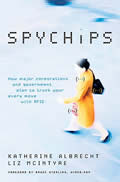Other
Dean
Articles:
JOIN THE JUNK FOOD BAN IN ARIZONA
Dr.
Carolyn Dean, MD, ND and
Elissa Meininger
January 5, 2006
NewsWithViews.com
With the holiday season over and the visions of sugar plums dancing in our heads fading and morphing into gas, bloating, dizziness, headaches, and fatigue, it�s time for our New Year�s Resolutions �both personal and political.
For many of us, we�ve vowed to diet away those few extra pounds that have crept up on us over the last year or two. However, what we don�t usually consider is that while some of our weight issues and related health issues may be a lack of discipline, much of them, these days, are thanks to the tricks of the trade used by the food industry to make what they sell more alluring to our sense of taste, smell, and vision.
In a Chicago Tribune series published last summer entitled, �Craving the Cookie,� the Oreo cookie was singled out as the prime example of the junk food industry hard at work to hook us into craving their products. Confected from sugar, flour and fat by Kraft Foods, Oreos, the world�s best-selling cookie, is hardly included in anyone�s diet as a health food.
As it turns out, researchers at Kraft Foods, 85% of which is owned by the Altria Group, have been routinely consorting with researchers at Philip Morris, 100% owned by Altria, regarding the nature of brain chemistry and addictions. Kraft has also consulted with Princeton University psychologist, Bart Hoebel, whose study supported the idea that sugar, in particular, can have addictive properties. [Read]
It really doesn�t take a rocket scientist, a psychologist, or food specialist with a fancy degree to prove that sugar makes food more alluring. This fact has been known for centuries all over the world. The problem is the sheer volume of sugar we are now eating without having a clue as to its dangers. Consider that we only have about 2 teaspoons of sugar in our blood stream at any one time, yet we unconsciously down a can of soda that contains 10 teaspoons. Now, that�s gotta hurt something!
In earlier times, here in America, sugar was a weekly treat in the form of some favorite candy that our mothers consented to, only if we were good. Now, liquid sugar, which is the proper name for soda, is practically inhaled by the liter and sugar-loaded confections are eaten by the pound, often disguised as a regular meal. It�s the probable cause of obesity and diabetes but the sugar industry won�t admit that and won�t let you say it either. They assume plausible deniability and say that sugar is only �scientifically� responsible for decaying teeth, for which they advise poisonous fluoride treatments as a preventative �a topic for a future NewsWithViews.com article.
The sugar industry has taken as its theme song the lyrics from Mary Poppins that �a spoonful of sugar makes the medicine go down� and added an extra line to the song that sugar should be added to all the food we eat, as well. Elissa even found a brand of frozen turkey for sale last week, that contained sugar�you know, that raw, frozen, sumptuous bird you roasted all day and ate for dinner during the holidays that you thought was just made of turkey?
So, if you decide to take charge of your health and limit your sugar intake, your first line of defense is reading labels and knowing all the other names sugar goes by in the food industry. Yup. Sugar is an ingredient in all kinds of foods that you�d never suspect. It is also disguised with 100 different names such as maltitiol, sorbitol, sucrose, dextrose, fructose, lactose, glucose, maltose, succanat, turbinado, demerrara, molasses, high fructose corn syrup, maple syrup, honey, barley syrup, malt syrup, rice syrup, cane juice, syrup, and fruit juice concentrate.
If you still want the taste of sugar but not the health risks, you can go to your health food store and stock up on Stevia, a sweetener 200 times sweeter than sugar, made from the leaves of a tree that grows in Brazil. At least one brand now comes in six yummy flavors such as apricot nectar, chocolate raspberry, lemon drop, English toffee, vanilla cr�me, and Valencia orange so you can have fun adding them to all those great beverages you can find at trendy cafes. If Stevia doesn�t work for you, a New Year�s present is a new product that Betty Martini of anti-aspartame fame (www.dorway.com) says has been tested and comes up clean. It�s called Just Like Sugar made of chicory, calcium and orange peel and will be in health food stores as of January 2006.
However, if you are suffering from all those blah feelings acquired this past holiday season, and a quick diet to get rid of those extra pounds is not going to clean up your health, you may have a more serious problem than just eating too much sugar. You may have a good case of yeast overgrowth that, if not controlled, is the gateway to all kinds of diseases, some of which can hasten an untimely death. In truth, most of the people that I consult with are troubled by undiagnosed yeast overgrowth. It�s another important condition, much like vitamin and mineral deficiencies, that modern medicine has actively ignored.
Antibiotics, cortisone, the birth control pill, and a high sugar and white flour diet can overturn the friendly balance of organisms in your intestines and stimulate yeast overgrowth. Yeast produces up to 180 different yeast toxins in the body. Several of these toxins are alcohols and aldehydes that can actually make a person feel drunk without having touched a drop! Other toxins act to block hormones and even cause sugar and carbohydrate cravings.
I�m the medical advisor to The Yeast Connection a website devoted to continuing the work pioneered by Dr. William Crook regarding the link between yeast overgrowth and the diseases it causes. I invite you to investigate our site for healthy tips located at our Yeast Fighting Program link on how to avoid sugar and how to stay healthy through the new year and for years to come.
On the personal front, while you may have decided to take on the battle of the bulge and/or clean up your general health by getting sugar out of your diet, on the political front, your children are more than likely still at risk by just going to school. There is a battle raging between a number of school systems and the junk food industry that you may want to know about. In particular, the one reported by Associated Press (AP) in a December 30, 2005, story about an interesting showdown brewing in Arizona.
There is a new anti-junk-food law in Arizona. It was passed in the spring of 2005 and will take effect in July 2006. Because of the new law, the state�s Department of Education proposes a ban on all soft drinks, fried potato chips, doughnuts, sweet rolls, cupcakes, sports drinks, and other high-fat, high-sugar snacks.
According to the AP article, there is a 3-inch-thick folder of public comments at the Arizona Department of Education written by students, parents, teachers, food-service directors, concerned citizens, and companies. The opinions vary on what should be done. Soft-drink companies have sent representatives to the Department�although they may concede that cans of soda containing 10 tsp of sugar might be banned, they argue that the school system should keep diet soft drinks available! If you read our December 30, 2005, article (LINK) you know that aspartame, the chemical sweetener in diet products is not a safe substitute and citizens in neighboring New Mexico are trying to ban it altogether.
Arizona officials have their hands full listening to all the opinions flying around �including the fast food industry, which says the rise in obesity in our children has nothing to do with their products but blame it on lack of exercise.
Dairy farmers complain that only allowing milk with 1 percent fat in school vending machines is too restrictive on their industry. Others say the more urgent problem with dairy is the use of genetically-engineered bovine growth hormone, antibiotics, and other drugs that may make milk harmful, not by the percentage of fat content but the toxins stored in the dairy fat.
Gatorade, with its 14 grams of sugar per serving, fired off a four-page letter defending its widely advertised drinks as necessary for fluid replacement and to fuel muscles. If it contained magnesium and a lot less sugar, I might agree, but not otherwise.
Under the heading of �the lesser of two evils� some companies are trying to promote their own brand of donuts as a healthier breakfast than the high fat, high sugar confections made by competitors--that the Arizona Republic pointed out to be Dunkin� Donuts and Krispy Kreme.
The Arizona Republic also noted that more than weight would be lost when junk food is banned. The paper�s research showed that some high schools are selling more than $30,000 in snacks annually, with that money going to support athletics, school clubs and other extracurricular activities � activities that school boards claim they can�t afford. Consequently, banning them altogether is turning out to be a hard sell for some people.
While many people say the government should not get involved with what people eat, and we basically agree --except when corporate influence is so great and there is no level playing field for the consumer. So, in this battle, we believe there is a role for parents, local school boards, and communities to insist that what is available to eat in the schools provides the proper nourishment for children to think and to learn.
While citizens in Arizona and several other places have taken a stand on getting the junk food out of the schools in an attempt to address the nation�s obesity problem, a more positive approach would be to overhaul the cafeteria and not just ban junk in the vending machines. Why not provide a wide-ranging nutrition program that would not only encourage children to eat right but also teach them how to eat for a lifetime.
Such a program is already in place in Manitowoc, Wisconsin, and is a partnership between a local natural foods business named Natural Ovens Bakery and a local school. The program is the brainchild of Barbara Reed Stitt and Paul Stitt PhD. In the Natural Ovens program, nonchemically processed food low in fat, salt, sugar, and fresh fruits and vegetables are the basis for the program. Fresh water is available throughout the day at the school. You can read about the remarkable success of this program at [Read]. You can also watch a video and order packets of information to help educate your school about good nutrition to help encourage them to adopt a more natural food program.
Similar work has been undertaken by the Dietary Research Foundation (DRF) run by Stephen J. Schoenthaler, Ph.D. and Ian D. Bier, N.D., Ph.D. at The Anthony Elementary School in Leavenworth, Kansas.
The DRF is an outfit dedicated to advancing the knowledge of the interaction between human nutrition and cognition, behavior, and intelligence. Even more interesting is that Dr. Schoenthaler is a professor of Criminal Justice at California State University and has published numerous papers on the subject and successfully completed about a dozen similar nutrition studies. Dr. Bier, has also published papers on nutrition and behavior.
We conclude this article with the following report by Drs. Schoenthaler and Bier. It shows the broad scope of what a really comprehensive nutrition program can actually do for your children in your local public schools.
THE ANTHONY ELEMENTARY SCHOOL EAT EXERCISE AND EXCEL PROGRAM IN LEAVENWORTH, KANSAS
An
Intermediary Evaluation Report
from The Dietary Research Foundation,
April 30th 2005
by Stephen J. Schoenthaler, Ph.D. &
Ian D. Bier, N.D., Ph.D. President Medical Director
Dietresearch.org (209) 293-1386
Abstract
Context: The administration and staff of Anthony Elementary School in Leavenworth Kansas suspected that their students� inadequate academic performance was due, in part, to high amounts of violence in school, �out of control� behavior, and other antisocial behaviors which were related to poor nutrition and other lifestyle factors. A literature review found a number of randomized controlled clinical trials that reported lower antisocial behavior and/or higher academic performance when vitamin-mineral supplements were compared with placebo among schoolchildren or delinquents. Similar results have been reported when nutritional modification was limited to improving available food choices. Behavior had improved between 38% to 90% depending on the population and interventions. These studies suggested that implementation of the interventions could significantly lower the behavior problems in Anthony and raise academic performance.
Objectives: To determine if schoolchildren, in Kindergarten to 5th grade, who are given: (a) low dose vitamin-mineral tablets, (b) nutritional education, (c) more nutritious foods, (d) daily exercise, physical fitness training, (e) structured activity time instead of unstructured recess, and (f) eating meals in the classroom family style instead of the cafeteria will produce (1) significantly less antisocial behavior at school and (2) improve Math and English scores on statewide standardized tests.
Design: A quasi-experimental time-series design in which all changes are implemented at the beginning of the 2003-2004 academic year and using the previous year as baseline data.
Settings and Subjects: An economically disadvantaged elementary school with approximately 350 students, similar demographically to major Eastern inner-city schools. About two-thirds of participants were minority students. In years previous to the study Anthony Elementary had the highest violence and antisocial behavior, and lowest scores in both standardized Math and English tests in their 10 school district.
Intervention: Daily vitamin-mineral supplementation at 100% of the USRDA for all vitamins and all minerals (except calcium and magnesium) in a phytonutrient base. This was supported by daily structured exercise replacing unstructured recess, nutritional education, a revised school breakfast and lunch menu stressing better nutrition, and family style eating in the classroom replacing cafeteria meals.
Outcome Measures: Violent and non-violent delinquency as measured by official school disciplinary records, and Math and English scores on the Kansas Assessment tests, as standardized test given to 4th and 5th grade Kansas elementary school children every year.
Results: During the baseline year just over 2 students per weekday were referred to the principal�s office for disciplinary action for �out of control� behavior, an annual rate of 438 incidents. During the intervention year, such referrals fell by 95% (438 to = 18). Referrals for disciplinary action for such behavior remains decreased 95% during this second year of implementation. Out of school suspensions fell from 52 to 13, an 80% decrease, and in school suspensions for violent acts fell from 34 to 1, a 97% decrease. Teachers also reported far less difficulty maintaining classroom control, allowing the focus to shift from classroom management to teaching issues. Teacher attrition declined from five to one per year. Most dramatically, scores on the Math and English portions of the Kansas Assessment test rose from 10th or last in the district rank to 1st in Math and 2nd in English scores.
|
Subscribe to the NewsWithViews Daily News Alerts! |
Conclusions: Previous clinical trials have shown that poor nutritional habits in children lead to low concentrations of water-soluble vitamins in blood, thereby impairing brain function, and subsequently leading to violence, other serious antisocial behavior, and lower academic performance. These clinical trials showed that correction of nutrient-intake, through either a well-balanced diet, or low-dose vitamin-mineral supplementation usually correct the low concentrations of vitamins in blood, improve brain function, and subsequently lower institutional violence and antisocial behavior significantly. This study adds to the literature by showing that the above clinical findings can be generalized to disadvantaged elementary schools using relatively simple policy changes and implementation rather than being limited to the artificial environment of the clinical trial. The program also underscores the importance of classroom control in learning. This program should be continued, replicated in middle and high schools, and replicated in non-disadvantaged schools to see if the behavioral and academic improvements are similar.
Elissa
and I thank you for all your kind emails and wish you all a Happy
New Year!
ACT
FOR HEALTH FREEDOM NOW:
Go to www.friendsoffreedominternational.org
view and purchase the new movie on Codex and Free Trade called "We
Become Silent" by Kevin Miller
Also purchase "Death
by Modern Medicine." Proceeds from the sale of these products
are crucial to help us fund our health freedom action. For state action
go to: www.nationalhealthfreedom.org.
� 2006 Carolyn Dean -
All Rights Reserved
Dr. Carolyn Dean is a medical doctor, naturopathic doctor, herbalist, acupuncturist, nutritionist, as well as a powerful health activist fighting for health freedom as president of Friends of Freedom International. Dr. Dean is the author of over a dozen health books, the latest of which is "Death By Modern Medicine".
Elissa Meininger, is Vice President of Friends of Freedom International and co-founder of the Health Freedom Action Network, a grassroots citizens' political action group. She is also a health freedom political analyst and can be heard on the natural health radio show SuperHealth, broadcast weekly on station WKY (SuperTalk AM 930) in Oklahoma City.
Website:
www.deathbymodernmedicine.com
Website: www.carolyndean.com
E-Mail: holeopharm@pol.net
It
really doesn�t take a rocket scientist, a psychologist, or food specialist
with a fancy degree to prove that sugar makes food more alluring. This
fact has been known for centuries all over the world.











